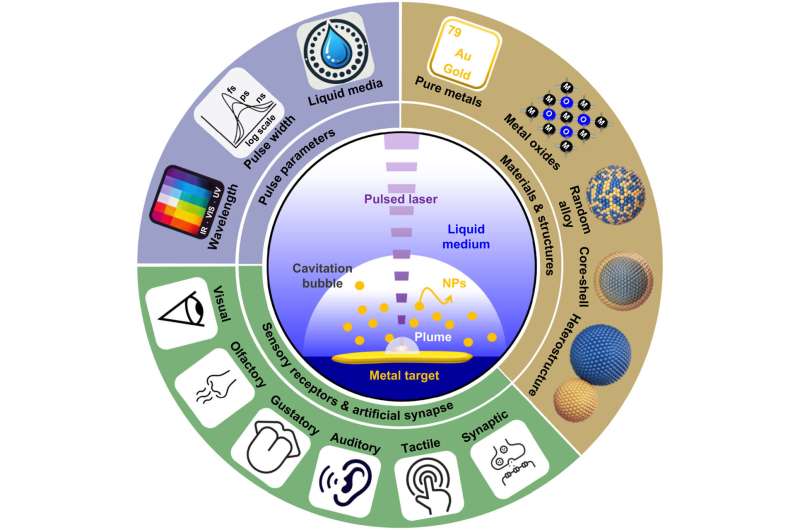Science
Laser Technology Advances Nanoparticle Production for Smart Sensors

A recent review published in the International Journal of Extreme Manufacturing outlines a groundbreaking method for producing ultra-clean, customizable nanoparticles. This technique, known as laser ablation in liquids (LAL), utilizes sub-nanoscale laser pulses to disintegrate solid metal targets submerged in liquids, presenting a cleaner alternative for developing artificial sensory systems that emulate human perception.
Researchers from Ajou University and Samsung Electronics detail the mechanics of LAL, emphasizing its potential to create metal-based nanoparticles without the harsh chemicals typically required in traditional chemical synthesis methods. This innovation is particularly relevant for the growing fields of extended reality (XR) and advanced human-machine interfaces.
Understanding Laser Ablation in Liquids
The initial section of the review delves into the scientific principles behind LAL. It discusses how various parameters—including laser wavelength, intensity, and pulse duration—affect the characteristics and scalability of the nanoparticles produced. Additionally, the study highlights engineering improvements such as continuous flow systems and laser steering, which enhance both efficiency and control over the nanoparticle formation process.
The review illustrates how LAL can yield highly pure metal nanoparticles that can be tailored in size, shape, and composition. These particles are surfactant-free, facilitating better interaction with their environment and leading to sensors that are not only faster but also capable of performing multiple functions simultaneously.
Real-World Applications and Future Prospects
The second half of the article shifts focus to practical applications of the nanoparticles generated through LAL. The review notes that these metal-based nanoparticles—ranging from single metals to complex alloys—are increasingly employed in devices designed to replicate the five human senses and even artificial synapses.
For example, nanoparticles composed of noble metals with customized surface properties can significantly improve light or gas detection capabilities. Moreover, high-entropy alloy nanoparticles show promise in hydrogen sensors and memory devices that mimic cognitive functions akin to brain activity.
Prof. Sungjun Park, the corresponding author of the study, states, “Laser ablation in liquids offers a clean and scalable way to produce high-performance nanomaterials. This could fundamentally change how we design and integrate materials for flexible electronics and smart sensory systems.”
Despite the clear advantages of LAL, challenges remain. Key issues include ensuring the long-term stability of the nanoparticles without surfactants and successfully integrating the LAL process into large-scale electronics manufacturing. The authors of the review suggest that future research should concentrate on developing continuous production systems, real-time monitoring capabilities, and functional devices that push the boundaries of nanoparticle performance.
As technologies become increasingly integrated into daily life, laser ablation in liquids could play a pivotal role in bridging the gap between nanomaterial synthesis and biologically inspired computation. This advancement offers a new perspective on engineering materials designed for machines that perceive, feel, and think in ways that more closely resemble human capabilities.
For further details, refer to the article by Jun-Gyu Choi et al., titled “Scalable metal-based nanoparticle synthesis via laser ablation in liquids for transformative sensory and synaptic devices,” published on July 21, 2025, in the International Journal of Extreme Manufacturing. The article is accessible via DOI: 10.1088/2631-7990/ade836.
-

 Technology5 months ago
Technology5 months agoDiscover the Top 10 Calorie Counting Apps of 2025
-

 Technology3 weeks ago
Technology3 weeks agoOpenAI to Implement Age Verification for ChatGPT by December 2025
-

 Health3 months ago
Health3 months agoBella Hadid Shares Health Update After Treatment for Lyme Disease
-

 Health3 months ago
Health3 months agoAnalysts Project Stronger Growth for Apple’s iPhone 17 Lineup
-

 Health4 months ago
Health4 months agoErin Bates Shares Recovery Update Following Sepsis Complications
-

 Technology5 months ago
Technology5 months agoDiscover How to Reverse Image Search Using ChatGPT Effortlessly
-

 Technology3 months ago
Technology3 months agoElectric Moto Influencer Surronster Arrested in Tijuana
-

 Technology5 months ago
Technology5 months agoMeta Initiates $60B AI Data Center Expansion, Starting in Ohio
-

 Technology2 months ago
Technology2 months agoDiscover 2025’s Top GPUs for Exceptional 4K Gaming Performance
-

 Technology5 months ago
Technology5 months agoRecovering a Suspended TikTok Account: A Step-by-Step Guide
-

 Health5 months ago
Health5 months agoTested: Rab Firewall Mountain Jacket Survives Harsh Conditions
-

 Lifestyle5 months ago
Lifestyle5 months agoBelton Family Reunites After Daughter Survives Hill Country Floods















